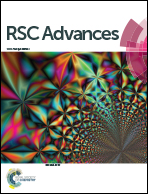Synthesis and optical properties of composite films from P3HT and sandwich-like Ag–C–Ag nanoparticles
Abstract
Sandwich-like Ag–C–Ag nanoparticles (Ag–C–Ag NPs) were synthesized under mild hydrothermal conditions in a one-step method. With this approach, Ag was not only encapsulated in the centre of an individual carbon nanosphere, but was also uniformly dispersed within the carbon matrix up to the sphere's shell. Then, poly(3-hexylthiophene):Ag–C–Ag NPs (P3HT:Ag–C–Ag NPs) composite films were prepared by a spin coating method with a chlorobenzene solution of Ag–C–Ag NPs and P3HT. Both morphology and microstructure of Ag–C–Ag NPs were investigated by field emission scanning electron microscopy and high resolution transmission electron microscopy. The possible formation mechanism was proposed. The results have indicated that the Ag–C–Ag NPs present many functional groups and their energy levels match with those of P3HT. It has been observed that an introduction of Ag–C–Ag NPs to P3HT can induce broad and high-absorbing spectra as well as great photoluminescence quenching of P3HT. It is evident that sandwich-like Ag–C–Ag NPs have a great potential to be a new acceptor material in photovoltaic devices.


 Please wait while we load your content...
Please wait while we load your content...